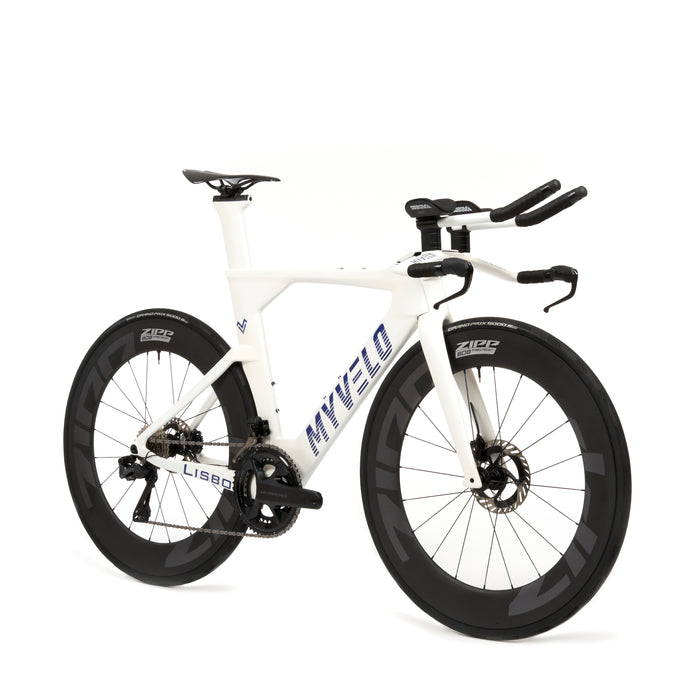
Lisboa triathlon bike
incl. FREE shipping & free returns

The correct tire pressure leads to less tire wear and ensures a comfortable driving experience. Therefore, it is all the more important to know how to measure and set the correct tire pressure.
Von Fabian Huber |
7 minutes read time

When it comes to the ideal tire pressure for your bike, a small adjustment often makes a big difference. Tire pressure is a crucial factor when it comes to comfort, grip and safety. Measuring and determining the correct tire pressure is not difficult. So that you can enjoy your tires for a long time and travel well with the correct air pressure, we have put together helpful tips, a table with air pressure information for different models and tricks for measuring tire pressure in this article.
The tire pressure of a bicycle depends on a number of conditions. The tire size, the surface and the weight are important factors in determining the correct tire pressure. Values are given on each tire and should be understood as guidelines. On the side of the tire you can see what the minimum and maximum tire pressure should be. If the tire pressure is in the middle of both values, in many cases your bike has the ideal air pressure.
Good to know: The air pressure in bicycle tires is given in two units of measurement. The pressure is either given in bar or in psi. If you want to calculate the air pressure from bar to psi, the rule applies: 1 bar is 14.5 psi.
It is important that the tire pressure does not fall below or exceed the values indicated on the tire. If the pressure is far below the minimum value, the tire is under-inflated and this can lead to damage to the tube or rims. If the tire pressure on your bike is far above the maximum value, the tire can burst.
Whether a high or low tire pressure makes sense for your bike depends on various factors. Firstly, the surface plays a role. But the type of tire, body weight and type of bike also influence the level of tire pressure.
A slightly higher air pressure is useful in the city on asphalt roads. By adjusting the tire pressure, you achieve lower rolling resistance, less wear and tear, and are less susceptible to breakdowns.
Note: If the tire is thin, it requires a higher air pressure. Wide tires are more robust and therefore require a lower air pressure. The latter also applies to tubeless tires . If they have a wide rim, tubeless tires can be used with less air pressure.
If you often ride on uneven and bumpy hiking and forest paths, you should adjust the tire pressure of your bike a little lower. A lower air pressure offers better grip and more comfort when riding on this surface, as it has a dampening effect.
Note: The range should always be between minimum and maximum. If the tire pressure is above or below the values indicated on the side of each tire, the above benefits no longer apply.
To help you determine the tire pressure for your bike, you can find an overview here. The information varies depending on the model and tire size.
| type of bike | tire width in mm (for MTB and Fatbike in inches) |
tire pressure in bar | tire pressure in psi |
| trekking bike | 35 |
4.5 |
65.3 |
| trekking bike | 40 | 4.0 | 58.0 |
| trekking bike | 50 | 3.0 | 43.5 |
| road bike | 25 | 7.0 | 101.5 |
| road bike | 28 | 6.0 | 87.0 |
| gravel bike | 35 | 4.5 | 65.3 |
| mountain bike | 2" | 3.0 | 43.5 |
| mountain bike | 2.3" | 2.0 | 29.0 |
| mountain bike | 2.5" | 1.8 | 26.1 |
| fat bike | 20 | 0.5-0.8 | 7.25-11.6 |
The values in the table refer to a cyclist with a body weight of 75 kilograms. With every additional kilogram of body weight, the air pressure in the tire should increase by 1 percent.
To give you an even better riding experience, the tire pressure for the front and rear wheels can be adjusted individually. The table shows the tire pressure of the front wheel. For the tire pressure of the rear wheel, you can add an additional 0.2 bar to the table value.
If the information in the table does not suit you and your bike, you can use the following formula:
Value in the table + adjustment to your body weight = guideline for tire pressure + 10% surcharge for e-bikes
Good to know: If you are travelling with a lot of luggage, a lot of weight is placed on the rear wheel. For an even better riding experience, it is therefore advisable to increase the tyre pressure of the rear wheel slightly.
Since the tires of an e-bike or pedelec do not differ fundamentally from those of other models, you can also read the tire pressure on the side of an e-bike.
However, the load on an e-bike or pedelec is higher because they have an additional motor and battery built in. The additional weight of the motor and battery means that higher air pressure is required in the tires. If you base your calculations on the values in the table, you should add a surcharge of 10%.
City and trekking bikes are considered real all-rounders. You can ride them on different surfaces. Therefore, a tire pressure in the middle range is a good choice. Depending on the weight and tire size, the air pressure for the bikes can be adjusted slightly upwards so that the rims are not damaged when driving over curbs and other uneven surfaces.
Mountain bikes are at home in rough terrain. This requires a lot of comfort and additional grip. Challenging trails and gravel paths are no problem for the wide tires of mountain bikes.
The correct tire pressure is particularly important in this area. The tire pressure should be a little lower to achieve a good driving experience. The pressure can be adjusted individually depending on the rim and tire width. If you ride your bike in the city, a tire pressure of around 3 bar is a good guideline.
If you are doing sporty mountain biking and use tubeless tires, you can adjust the pressure downwards a little. Tubeless tires do not have a tube, so they are highly puncture-proof and lower pressure does not damage the tire.
With a racing bike you can travel quickly and preferably on asphalt roads. In this area, rolling resistance is crucial. This should be as low as possible, which is why high air pressure is important. The high air pressure ensures that the racing bikes roll more easily and an increased vibration can be felt while riding. As a rule of thumb, you can use 10 percent of your body weight in bars.
Tip: A racing bike loses pressure faster than a trekking or city bike, so you should check the tire pressure more often on a racing bike.
The gravel bike is visually very similar to the racing bike. However, the gravel bikes have a tire profile that is suitable for off-road trails. Therefore, with these models you should pay particular attention to the surface and adjust the tire pressure accordingly. This often means that the pressure is adjusted slightly downwards so that you can ride better on uneven surfaces.
A folding bike is a great choice for commuters and travelers , as the bikes can be folded up quickly and easily in just a few steps. This means that you can take them with you on public transport or in the car without taking up much space. The MYVELO Rio and Palma e-bike folding bikes have these practical advantages.
A special feature of the two folding bikes is that, as fat bikes, they have very wide tires. If you want to calculate the tire pressure for the Palma or Rio folding bikes, you should refer to the information on the tire, as with other models.
Note: Fat bikes require a lower tire pressure and often get by with 0.5-0.8 bar. The low tire pressure gives the folding bike optimal damping and better grip.
To reliably measure the tire pressure of your bike , a floor pump with an integrated pressure gauge is the right choice. Small mini pumps are a practical helper for bike tours, but they cannot measure the tire pressure precisely.
To measure the air pressure in the tire, you have to put the pump head of the air pump on the bicycle valve. You can then read the tire pressure from the display on the pressure gauge.
Note: If you don't have a pressure gauge, you can check the air pressure by using your thumb. This method is not exact, but it does give you a good indication. It's best to press the bicycle tires together a little at the sides, as the pressure is easier to feel in this area. Tire pressure of 2 bar or more feels very full.
To find the perfect tire pressure for you and your bike, it is recommended to test different values. To do this, make a note of the starting value and adjust the air pressure either slightly upwards or downwards. A short test ride will show you whether the pressure is already correct. If you are not satisfied, you can adjust the air pressure again until you have found the right mix of comfort, grip and rolling resistance.
You don't know when you last checked the tire pressure on your bike? Then it's time to take a measurement. If you regularly ride your bike, you should also check the air pressure at regular intervals. It's especially worth taking a close look at the wheels and the air pressure before long bike rides.
Even without damage, a tire can lose up to 1 bar per month. By regularly checking your tire pressure, you can travel safely and quickly on the roads.
Tip: If you are riding your bike in winter , a lower air pressure is recommended. Slippery roads and paths can be ridden better with increased grip.
The perfect tire pressure for your bike depends on different values. The total weight of the bike, your body weight, the surface and the type of bike all play an important role. Therefore, the tire pressure cannot always be set perfectly the first time. Testing different values is helpful to achieve a tire pressure that is perfectly suited to your riding style.
For e-bikes, add 10% of the air pressure to each guideline value, as the motor and battery represent additional weight.
If the tire pressure stays within the values indicated on the tire, you are safe on your bike. If you also pay attention to the information for the different models, you will soon find the perfect air pressure to ensure a good ride and comfort.
Get advice from cycling enthusiasts